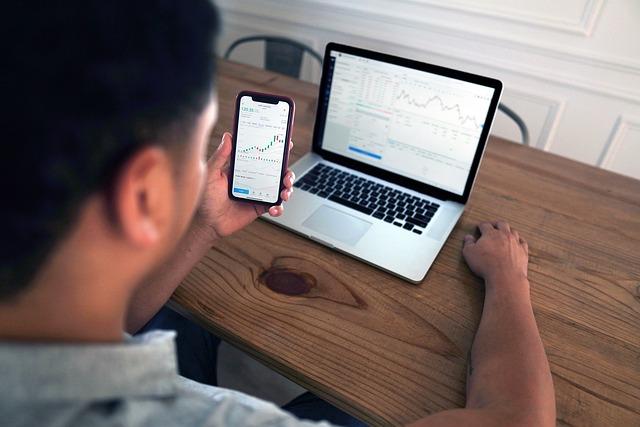So, you’ve been hearing all the buzz about trading and wondering how to jump in without getting overwhelmed? Whether you’re looking to make a little extra cash or hoping to turn trading into a serious hustle, starting out can feel like diving into a sea of confusing charts and jargon. but don’t worry – trading doesn’t have to be scary or elaborate! In this post, we’re breaking down some super simple tips that anyone can use to start winning today. Ready to make your money work for you? Let’s get into it!
Getting to Know the Market Without Feeling Overwhelmed
Jumping into the world of trading can feel like trying to drink from a firehose – facts and options everywhere! The key is to break it down into bite-sized pieces. Start by focusing on just a few markets that interest you, whether it’s stocks, forex, or cryptocurrencies. Resist the temptation to dive into everything at once. Rather, get cozy with how these markets move, what drives their prices, and the basic terminology. Consistency beats complexity, so spending just 15 minutes a day reading market summaries or watching beginner-amiable videos will build your confidence without overload.
To keep things manageable, create a simple checklist of essentials that you can refer to regularly:
- Understand market hours: Know when your chosen market is most active to spot good trading opportunities.
- Follow major news: Market-moving events frequently enough start from big headlines; keeping an eye on them is crucial.
- Pick your tools: use basic charting platforms or apps that help visualize price movements without complex jargon.
- Set learning goals: Maybe it’s mastering candlestick charts this week or understanding support and resistance.
| Tip | Why It Helps |
|---|---|
| Start Small | reduces risk and emotional stress |
| Use Demo Accounts | Practice without losing real money |
| Stay Updated | Prepares you for sudden market moves |
| Keep a Trading Journal | track progress and learn from mistakes |

Choosing the Right Trading Platform That Fits Your Style
Finding a platform that matches your unique trading vibe is a game-changer. Some traders thrive on slick,high-tech interfaces with loads of charting tools,while others prefer simple layouts that get straight to the point. Look for platforms that offer customizable dashboards, so you can tailor your experience without feeling overwhelmed. Don’t forget to check if the platform supports your preferred asset types, whether it’s stocks, forex, crypto, or commodities. A good fit means you spend less time battling the software and more time making smart moves.
Here’s a rapid cheat sheet on what to consider when scanning for your perfect match:
- User-friendly design: Easy to navigate, even when you’re on the go.
- Educational resources: Tutorials and tips to level you up without extra Googling.
- Security features: Two-factor authentication and data encryption protect your info.
- Fees and commissions: low costs help keep more profits in your pocket.
| Feature | Why It Matters | Starter-Friendly Platforms |
|---|---|---|
| Demo Accounts | Practice risk-free with virtual money. | eToro, TD ameritrade |
| Mobile App | Trade anytime, anywhere with ease. | Robinhood, Binance |
| Customer Support | Get help fast when you’re stuck. | Interactive Brokers, Plus500 |
Mastering Basic Strategies That Actually Work for Beginners
When you’re just starting out in trading,it’s easy to get overwhelmed by all the noise. The key to gaining confidence and making consistent progress lies in sticking to a few simple,proven strategies that won’t burn you out or drain your account right away. One effective approach is to focus on trend-following, which means buying when prices are moving up and selling when they’re in a downtrend-don’t fight the market! coupling this with strict risk management-like never risking more than 2% of your trading capital per trade-helps protect your hard-earned money and keeps your emotions in check.
Another great beginner tip is learning to spot entry and exit points without complicating things. Use basic tools like moving averages or simple candlestick patterns to identify when to jump in or get out. Here’s a quick reference for simple entry rules that often work:
- Buy Signal: Price crosses above the 20-day moving average
- Sell Signal: Price drops below the 20-day moving average
- Stop loss: Set it just below the recent swing low
- Take Profit: Target a 2:1 reward-to-risk ratio
| Strategy | Benefit | key Reminder |
|---|---|---|
| Trend Following | Aligns with market momentum | Be patient-don’t force trades |
| Risk Management | Keeps losses manageable | Stick to your 2% rule |
| Simple Indicators | Easy to understand & implement | Use moving averages & candles |
Keeping Your Emotions in Check to Avoid Costly Mistakes
Keeping a cool head when trading can make a massive difference between scoring wins and watching your hard-earned money slip away. Emotional decisions often lead to impulsive trades that don’t align with your strategy. To keep emotions in check, try setting strict entry and exit rules beforehand and stick to them no matter what. Remember, the market doesn’t owe you anything, and chasing quick profits can send you down a risky path fast. When you feel stressed or excited, take a moment away from the screen – breathe, relax, and return with a clearer mind.Small pauses can prevent huge losses!
- Track your emotions: Keep a journal of how you feel during trades to spot patterns
- Use stop-loss orders: Automatically limits your losses so you don’t act out of panic
- Practice mindfulness: Techniques like meditation can improve focus and reduce impulsive moves
| Emotion | Common Mistake | Quick Fix |
|---|---|---|
| Fear | Exiting too soon | Set clear targets & trust your plan |
| Greed | Overtrading | Limit daily trades |
| Frustration | Revenge trading | Take a break & review your strategy |
Setting Realistic Goals and Tracking Your Progress Like a Pro
Before diving into the world of trading, setting achievable targets is key to keeping your motivation high and frustration low. Start by outlining what you want to accomplish within realistic timeframes-whether that’s mastering one trading strategy per month or hitting a certain profit percentage each quarter. Break your big goals into smaller, manageable steps, and don’t forget to celebrate those mini milestones! This approach not only keeps you focused but also makes the learning curve feel a whole lot less intimidating.
Tracking your progress like a pro means staying organized and honest with yourself. Use tools like trading journals or apps to log every trade, jot down why you made decisions, and note the outcomes. Here’s a quick glance at a simple tracking template you can customize to fit your style:
| date | Trading Pair | Entry Price | Exit Price | Outcome | Lesson Learned |
|---|---|---|---|---|---|
| 04/20/24 | BTC/USD | $40,000 | $41,200 | Profit | Waited too long to exit |
| 04/22/24 | ETH/USD | $3,200 | $3,150 | loss | Missed stop-loss alert |
By regularly reviewing and analyzing your trades,you’ll spot patterns in your wins and losses,helping you fine-tune your strategy and avoid repeating mistakes. Remember, the best traders are those who treat every trade as a learning opportunity-track smart, adjust quick, and keep growing!
Q&A
Q&A: Trading for Newbies – Easy Tips to Start Winning Today!
Q: I’m new to trading. Where do I even begin?
A: Great question! Start by learning the basics – understand what stocks, forex, or crypto are, depending on what you want to trade. Think of it like learning the rules before playing a game. Next, open a demo account with a broker to practice without risking real money. Getting comfy with the trading platform and market movements before jumping in is key.
Q: How much money do I need to start trading?
A: Honestly, it depends on the market and broker, but many platforms let you start with as little as $50 to $100. Don’t go in thinking you’ll get rich overnight. Start small, only use money you can afford to lose, and focus on learning first.
Q: What’s the easiest trading strategy for beginners?
A: Simple is best! Many newbies start with “buy and hold” – buying a stock or asset and holding it for a while as it gains value. another beginner-friendly strategy is “trend following,” where you look for assets moving consistently up or down and trade along with that momentum.avoid complicated stuff until you feel more confident.
Q: How can I manage my risks?
A: Risk management is your BFF. Always use stop-loss orders – these automatically sell your asset if it drops to a certain price, protecting you from big losses. Also, never put all your cash into one trade. Diversify and only risk a small percentage (like 1-2%) of your total capital per trade. Protecting your money is more critically important than chasing crazy gains.
Q: Should I follow trading “gurus” or social media tips?
A: Be cautious here! There are tons of self-proclaimed experts out there,but not all advice is good or trustworthy. Learn to do your own research and verify info before acting on it.Social media can be inspiring but also misleading – don’t blindly follow hype.
Q: How much time should I spend trading or studying?
A: Treat trading like a part-time hobby at first. Spend time learning daily – read articles, watch videos, track markets.Actual trading can be as quick as a few minutes a day if you’re swing trading or longer if day trading. Patience is key. The more you learn now, the better your chances later.
Q: Any mindset tips for newbie traders?
A: Absolutely! Stay patient and don’t hype yourself up on quick wins. Except losses as part of the game and learn from them. Keep emotions like fear and greed in check – they can cloud your judgment. Think of trading as a marathon, not a sprint.
Q: What’s the best way to keep improving?
A: Keep a trading journal! Write down why you entered a trade,your emotions,and the outcome. Over time, this helps you spot patterns in your behaviour and strategies that work or flop. Also, keep learning – markets change, and so should your approach.
Q: Can I really start winning today?
A: winning is a process, not an instant reality. You might make some good trades early on, but consistent success comes from practice, patience, and discipline. Follow these easy tips, keep learning, and your chances to win will grow every day.
Ready to dip your toes in trading? Remember, start slow, stay smart, and enjoy the ride. You’ve got this! 🚀✨
In Summary
and there you have it-trading doesn’t have to be some mysterious, complicated arena reserved for pros. With these easy tips in your back pocket, you’re already a few steps ahead of most beginners out there. Remember, the key is to start small, stay curious, and keep learning from every trade. So, take a deep breath, trust the process, and get out there-becuase your trading journey starts now, and who knows? Winning might be just around the corner. Happy trading! 🚀📈











